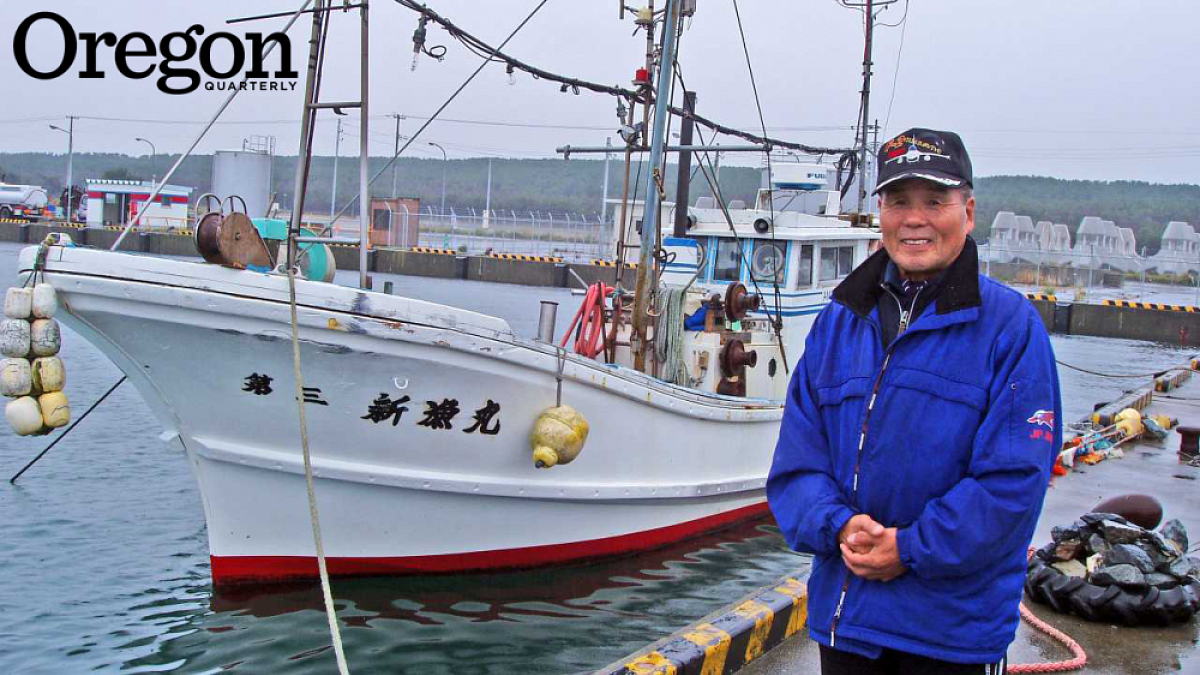Tatsuo Tachibana and the rest of the fishermen at the Port of Misawa were nearing the end of a long day when they felt the first sharp jolt of an earthquake the afternoon of Friday, March 11, 2011. None of them were particularly alarmed; earthquakes are a routine occurrence on the north end of Honshu, as they are throughout Japan. Tachibana and the others waited inside the market building for the shaking to stop. But it didn't stop, not for four long minutes. By then, all the fishermen in the long, low, steel building had the same thought: Get onto the open ocean. Tsunamis are rare events, generated only by very large quakes, and this one seemed pretty big. They could evacuate to higher ground, but that would leave their fishing boats—key to their livelihood and, for some, their families' largest investment—at risk of being destroyed. To a man, they dropped what they were doing and headed to their boats.
The fleet had returned to port hours earlier, quickly unloading the morning's catch of surf clams at the four floating docks jutting out from the concrete pier perpendicular to the wharf. Constructed of concrete and steel and stuffed with Styrofoam, the docks were extremely buoyant and as solid underfoot as the earth itself. Aluminum gangway ramps connected each floating dock to the fixed pier. Belt conveyors, one on each side of each ramp, also ran from dock to pier—that was the genius of these docks, installed just three years earlier. Before, the fishermen unloaded flats of squid or clams by hand, reaching them high overhead when the tide was low. Now, conveyor belts carried the flats up to the pier, where helpers stacked them on pallets and, within seconds, forklifts loaded the pallets into waiting trucks. The docks and conveyors had halved the time it took to unload the entire fleet's catch, from four or five hours to just two. And time was of the essence—the faster the fishermen in Misawa could unload their catch, the better the price they'd fetch at the fish market in Tokyo, an eight- to ten-hour drive south.
Tachibana had spent that morning at the helm of the smaller of his two boats, the 50-foot Shinryo Maru No. 3, pulling a hydraulic dredge to trawl for surf clams. Hokkigai, or hokki in local parlance, were in high demand in Tokyo, where sushi chefs preferred the sweet taste of northern clams over those from southern waters. Tachibana, 70, and his 34-year-old son worked the winter clam harvest together. During the longer, more lucrative squid season from late June to December, Tachibana ran the No. 3 and his son ran his second boat, the 75-foot Shinryo Maru No. 11.
Rather than heading home after unloading the catch that Friday afternoon, the fishermen had gathered in the market building. The end of hokki season was approaching, and on Sunday the fishermen would host the annual hokki matsuri—the surf-clam festival. The banners were already hung. Tachibana, head of the Misawa Fishery Cooperative's small-vessel division, was supervising the preparations: shelling clams and cutting samples for tasting. Vendors would be preparing and selling to-go dishes: hokki tempura, hokki with grated daikon radish, and hokki sushi, the quick-simmered tip of clam flesh bright crimson against a white block of rice.
The earthquake put a stop to all that. Tachibana told his son to start the engine on Shinryo Maru No. 11 while he headed to No. 3. Both boats were tied up at the wharf a short walk from the market building; the floating docks were used only for unloading, and in midafternoon they stood empty.
Not until the Shinryo Maru No. 3 was rounding the north jetty did Tachibana notice, with a glance over his shoulder, that the No. 11 hadn't moved from its moorage. He was a mile or so at sea when his boat crested one very long, low swell on an otherwise calm sea. Tachibana turned around and watched as the tsunami moved toward the shore. Then the land disappeared behind the great bulk of the cresting wave. It appeared to Tachibana that half the fleet was on the ocean now, maybe three dozen boats. As far as he could tell, the No. 11, his son's boat, was not among them.
* * *
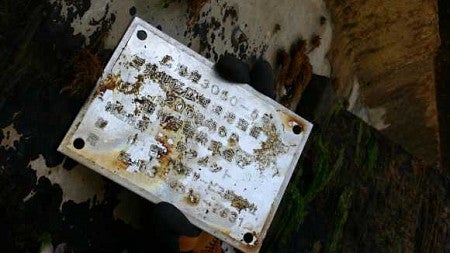
Fearing an invasion of nonnative marine life, state wildlife officials quickly had the dock scraped clean, burying two tons of sea life on the beach above the high-tide line (see sidebar below). Within a day, people were flocking to Agate Beach to see the dock. Two months later, the dock was gone, cut up and hauled away, its concrete destined for recycling into road-paving material. Set aside were the steel plaque, a section of dock adorned with blue waves by an Oregon graffiti artist, and the dock's 18 vertical rubber bumpers and 16 corroded but intact stainless steel boat tie-ups—to which the Shinryo Maru No. 3 had been secured so many times. The wave-adorned chunk would become the centerpiece of a monument at Hatfield Marine Science Center in Newport. State parks officials would distribute other artifacts to selected Oregon museums, including the University of Oregon Museum of Natural and Cultural History.
* * *
Misawa is not in the heart of the 2011 tsunami impact zone. It fact, it was the northernmost port on Honshu to be significantly damaged. Misawa's own fraction of that calamity—2.3 square miles of inundated coastal plain, $97 million in damage, 96 homes destroyed, a devastated fishing port, and two deaths—pales in comparison to that of towns and cities to the south. There, individual cities' death tolls numbered in the hundreds or thousands, and a nuclear catastrophe—the world's worst since the Chernobyl disaster in 1986—was set in motion. But that's the nature of disasters not our own: accumulations of intensely personal tragedies distilled into columns of numbers. This event was not without precedent in Misawa; tsunamis in 1933 and 1896 remain vivid in local memory, thanks to black-and-white photographs of wooden debris piles that were once family homes, of shivering survivors huddled outside makeshift lean-tos. The coincidence of a dock from that community showing up on the Oregon Coast 15 months after the most recent tsunami seems to underscore the connections between two far-removed points on the globe whose history, geology, economy, and fates were already surprisingly parallel.
* * *
Three miles north of the Port of Misawa, the two dozen children at Sabishiro Nursery School were nearing the end of their afternoon nap when the quake hit. They had expected to awaken to a party celebrating the school's three March birthdays. Instead, teachers grabbed sleeping infants and the older children did as they had been trained to do: they dove under the nearest table or desk, then headed outside as soon as the shaking stopped. The preschool sat at about 10 feet elevation and was located about a quarter-mile from the beach, just inside a 100-yard-wide forest of pine planted as a buffer after the 1933 Sanriku tsunami killed 26 people and destroyed 100 houses in Misawa. Even with that barrier forest, preschool director Noriko Moriya knew she needed to get the children out and up. Teachers, some with an infant under each arm, began leading the children to a community center up the hill as garbled voices on the town's public address system warned of a six-foot-high tsunami. Children and teachers jammed into the center's library until an aftershock sent them back outside. They resumed their chilly walk, stopping finally at the post office, where some teachers pulled out cell phones and tried to reach parents—cell phone service was spotty—and others flagged down panicked mothers driving toward the school.
Elsewhere in Misawa, hundreds of people were heading for high ground, though not as many as would have just a decade or two earlier. Misawa Air Base, home to more than 5,000 U.S. Army, Navy, and Air Force personnel as well as members of the Japan Self-Defense Forces, sits at the north edge of town. All day, every day, the roar of F-16 fighter jets on approach to the airfield can be heard east of the base. Twenty years ago, the Japanese government began tearing down houses under the flight path, relocating residents and leaving much of the low coastal plain fortuitously uninhabited.
No one had evacuated as quickly as the staff of the Misawa Fishery Cooperative, whose offices were at the port. They knew that harbors, like bays, tend to amplify the damage wrought by tsunamis. Seiichiro Umetsu was among the last to leave. Driving out of the port, he paused where the road began its rise through the barrier forest, and turned around for a last look. No wave had struck—yet—but the sea had begun to withdraw, as it often does prior to a tsunami. He noticed the port's four floating docks, no longer wedged neatly between tall pairs of steel pilings, but all drifting freely. Somehow they had come loose during the draw-down. At that, Umetsu turned around, put the car back in gear, and sped up the hill.
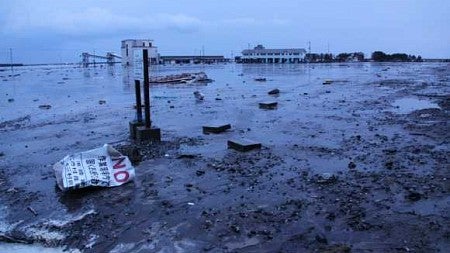
That was the last the fishermen of Misawa saw of their floating docks.
* * *
That wasn't the last sighting of the docks, however. Ten days after the tsunami, the crew of a coast guard plane spotted three large docks floating 50 miles off Japan's shore and nearly as far south as Tokyo. They were part of a huge debris field, of which only the largest pieces—fishing boats, mainly—could be identified from the air. A nearshore current runs south along the northern coast of Honshu; near Tokyo, it collides with the larger, northbound Kuroshio current, part of the great oceanic gyre that flows clockwise in the North Pacific Ocean. Here the three docks, and possibly the fourth, would have joined millions of tons of debris sweeping away from Japan and toward North America.
That at least one of the docks—riding high above the water, pushed by wind as well as current—would land on an Oregon beach months ahead of debris floating at or below the surface wasn't surprising to oceanographers. That a dock of this size wasn't reported by any ocean-going vessels between Japan and Oregon during its 15-month journey demonstrates just how vast the Pacific is, and how small in comparison is a 1,254-square-foot dock. A second dock from Misawa washed up on a remote Olympic Peninsula beach in December. As of this writing, two of the Misawa docks remain at large, though what appeared to be a third was briefly spotted off the north coast of Hawaii's Molokai island last September. Built to last, the docks could stay afloat for a very long time.
* * *
Residents returning to the port the day after the tsunami found everything in shambles. Magnified by the confines of the harbor, the highest of the waves to hit Misawa was taller than a two-story building. Eighty fishing boats were lost or destroyed. A huge fuel tank had been torn from its footings and relocated down the waterfront. Buildings were swept from their foundations; of those that stood, most were beyond repair. What used to be a paved road was now a deep gash in the sand. The breakwater was eroded. Although the steel pilings that had held the floating docks in place still stood, some were damaged, and the belt conveyors were a total loss, one of them upended and bent in half.
Returning to Sabishiro Nursery School, Noriko Moriya found that the one-story building had been inundated nearly to the rafters. Everything inside—children's clothing, toys, books, futons, furniture, and somewhere among the wreckage, a couple of decorated birthday cakes—was a sodden, jumbled mess. The retreating wave had torn a hole through the kitchen wall and left brightly colored plastic playground equipment piled against a mangled cyclone fence.
One mile to the north, shards of red-painted metal were scattered in the pines and across what had been a favorite beach among the troops at Misawa Air Base. It was here in 1931 that two American pilots had taken off on what would become the first successful nonstop flight across the Pacific Ocean, ending east of Wenatchee, Washington. That event is a local point of pride; images of the plane, the Miss Veedol, adorn everything from the business cards of Misawa city officials to the Styrofoam boxes in which fishermen ship their catch. The red shards were all that remained of a scale-model Miss Veedol marking the site of the original gravel runway.
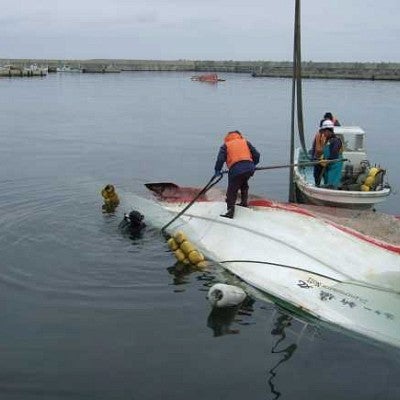
* * *
Nearly two years later, little evidence of the tsunami remains in Misawa. The preschool has been rebuilt at a new site up the hill, and a new Miss Veedol replica is in place at the beach. New floating docks and belt conveyors were installed within six months.
A short distance north of the port stands a knoll topped by a Shinto shrine dedicated to Konpira, guardian spirit of seafarers. Next to the shrine a tall concrete column shaped like a lighthouse rises from sculpted waves that dash at its base. Like the nearby barrier forest, it dates from soon after the 1933 tsunami. A translation of the monument's inset bronze plaque reads "Earthquake! The ocean roars. Look! Here comes a tsunami."
That reminder resonates on the Oregon Coast as well. "We live in an area that is, in many ways, a mirror reflection of Japan, an area where we are dependent upon the coast for our livelihood, and a geologically active area, an area that has had its history changed by past tsunamis," says Chris Havel, the Oregon State Parks official tasked with disposing of the dock that washed ashore at Agate Beach and preserving pieces of it for posterity. Both Japan and Oregon sit at the junctures of colliding tectonic plates that periodically generate earthquakes and, when the quakes are large enough, devastating tsunamis. An underwater fault line known as the Cascadia Subduction Zone, similar to the Japan Trench off northern Honshu, runs on the seafloor off the Pacific Northwest coast from Vancouver Island to near Eureka, California. Geologists believe this fault line has been the source of infrequent but devastating tsunami-generating earthquakes—as many as 40 over the past 10,000 years. Oregon's last great tsunami struck 313 years ago. Exactly when the next one will hit is impossible to predict, but scientists insist it is a matter of when, not if. Unlike the citizens of Misawa, Oregonians have no photos, no memorial markers on coastal knolls to remind them to stay alert.
What they do now have are pieces of a dock: objects that signify one nation's losses, and another's past—and future.
Concrete Emissary
Jessica Miller, PhD '04, was in her office at Hatfield Marine Science Center one day last June when she started hearing buzz about a large piece of marine debris that had washed up a few miles north at Agate Beach. After work, she and some colleagues headed out to have a look at what had by then been identified as a dock from Japan. But it wasn't the dock per se that caught the biologists' interest. It was the mass of marine organisms clinging to every inch of the structure below the waterline—about two tons of biomass, according to the Oregon Department of Fish and Wildlife (ODFW). The next morning Miller, a marine fisheries ecologist and associate professor at Oregon State University's Coastal Oregon Marine Experiment Station, headed back out with bucket and shovel to take samples before ODFW staff members disposed of the hitchhiking sea life.
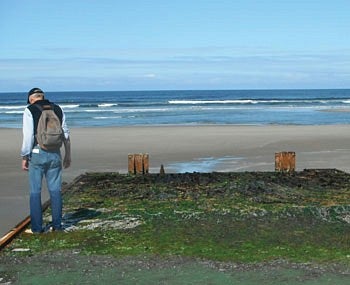
While others set to work identifying the algae, Miller began collaborating with scientists from around the United States, Canada, and Japan to identify nearly 100 species of fauna clinging to the dock. Some were harmless pelagic hitchhikers such as Lepas anatifera, the gooseneck barnacle beachcombers commonly find attached to driftwood or fishing gear stranded on the beach. Equally harmless were such species as Oedignathus inermis, the granular claw crab, native to both the Pacific Northwest and Japan. But they also found, alive and well and ready to reproduce, some less benign stowaways. The Japanese shore crab Hemigrapsus sanguineus, for example: a diminutive bully already running roughshod over Atlantic coast natives from North Carolina to Maine, where it's thought to be partially responsible for declines in lobster and Chesapeake Bay blue crab populations. And Asterias amurensis, a deceptively charming purple-yellow sea star and voracious predator that appears on the International Union for Conservation of Nature's hit list of the world's 100 worst invasive species.
With funding from Oregon Sea Grant and the National Science Foundation, Miller is helping, as she puts it, to "characterize the inoculation risk" posed by the potential arrival of more tsunami debris rife with marine life, along with monitoring any such debris that does arrive and educating the public about how to prevent the spread of invasive species. But as a biologist whose research interests are focused on the evolution, development, and maintenance of life history diversity in fishes, Miller is also interested in what the dock may reveal about how species have evolved and dispersed throughout the North Pacific and the role of transoceanic transport in that process. "It's not that common to have these kinds of communities being pulled out into the ocean currents and transported," she observes. "It's a fairly novel dispersal mechanism."
—By Bonnie Henderson
Bonnie Henderson '84 has been a writer and editor in the Northwest for 30 years. She is working on a book, The Next Tsunami, exploring how we know what we know about the Cascadia Subduction Zone, a fault line off the Oregon and Washington coast.
Thank you to Yoko O'Brien, MA '00, of the Department of East Asian Languages and Literatures for translation assistance.


